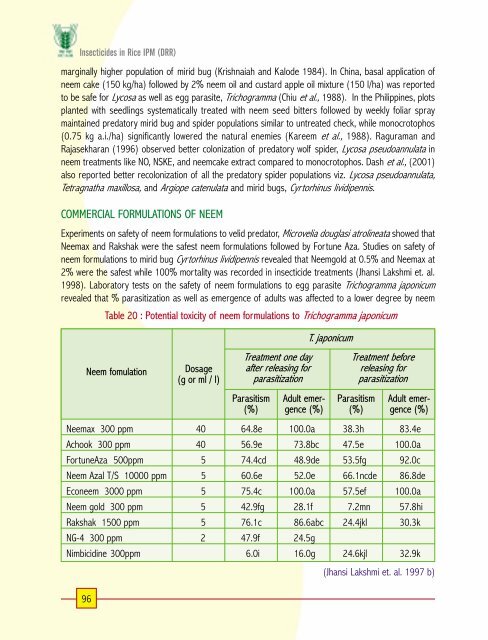priciples of insecticide use in rice ipm
priciples of insecticide use in rice ipm
priciples of insecticide use in rice ipm
Create successful ePaper yourself
Turn your PDF publications into a flip-book with our unique Google optimized e-Paper software.
Insecticides <strong>in</strong> Rice IPM (DRR)<br />
marg<strong>in</strong>ally higher population <strong>of</strong> mirid bug (Krishnaiah and Kalode 1984). In Ch<strong>in</strong>a, basal application <strong>of</strong><br />
neem cake (150 kg/ha) followed by 2% neem oil and custard apple oil mixture (150 l/ha) was reported<br />
to be safe for Lycosa as well as egg parasite, Trichogramma (Chiu et al., 1988). In the Philipp<strong>in</strong>es, plots<br />
planted with seedl<strong>in</strong>gs systematically treated with neem seed bitters followed by weekly foliar spray<br />
ma<strong>in</strong>ta<strong>in</strong>ed predatory mirid bug and spider populations similar to untreated check, while monocrotophos<br />
(0.75 kg a.i./ha) significantly lowered the natural enemies (Kareem et al., 1988). Raguraman and<br />
Rajasekharan (1996) observed better colonization <strong>of</strong> predatory wolf spider, Lycosa pseudoannulata <strong>in</strong><br />
neem treatments like NO, NSKE, and neemcake extract compared to monocrotophos. Dash et al., (2001)<br />
also reported better recolonization <strong>of</strong> all the predatory spider populations viz. Lycosa pseudoannulata,<br />
Tetragnatha maxillosa, and Argiope catenulata and mirid bugs, Cyrtorh<strong>in</strong>us lividipennis.<br />
COMMERCIAL FORMULATIONS OF NEEM<br />
Experiments on safety <strong>of</strong> neem formulations to velid predator, Microvelia douglasi atrol<strong>in</strong>eata showed that<br />
Neemax and Rakshak were the safest neem formulations followed by Fortune Aza. Studies on safety <strong>of</strong><br />
neem formulations to mirid bug Cyrtorh<strong>in</strong>us lividipennis revealed that Neemgold at 0.5% and Neemax at<br />
2% were the safest while 100% mortality was recorded <strong>in</strong> <strong><strong>in</strong>secticide</strong> treatments (Jhansi Lakshmi et. al.<br />
1998). Laboratory tests on the safety <strong>of</strong> neem formulations to egg parasite Trichogramma japonicum<br />
revealed that % parasitization as well as emergence <strong>of</strong> adults was affected to a lower degree by neem<br />
Table 20 : Potential toxicity <strong>of</strong> neem formulations to Trichogramma japonicum<br />
Neem fomulation<br />
Neemax 300 ppm 40 64.8e 100.0a 38.3h 83.4e<br />
Achook 300 ppm 40 56.9e 73.8bc 47.5e 100.0a<br />
FortuneAza 500ppm 5 74.4cd 48.9de 53.5fg 92.0c<br />
Neem Azal T/S 10000 ppm 5 60.6e 52.0e 66.1ncde 86.8de<br />
Econeem 3000 ppm 5 75.4c 100.0a 57.5ef 100.0a<br />
Neem gold 300 ppm 5 42.9fg 28.1f 7.2mn 57.8hi<br />
Rakshak 1500 ppm 5 76.1c 86.6abc 24.4jkl 30.3k<br />
NG-4 300 ppm 2 47.9f 24.5g<br />
Nimbicid<strong>in</strong>e 300ppm 6.0i 16.0g 24.6kjl 32.9k<br />
96<br />
Dosage<br />
(g or ml / l)<br />
Treatment one day<br />
after releas<strong>in</strong>g for<br />
parasitization<br />
Parasitism<br />
(%)<br />
Adult emergence<br />
(%)<br />
T. japonicum<br />
Treatment before<br />
releas<strong>in</strong>g for<br />
parasitization<br />
Parasitism<br />
(%)<br />
Adult emergence<br />
(%)<br />
(Jhansi Lakshmi et. al. 1997 b)











